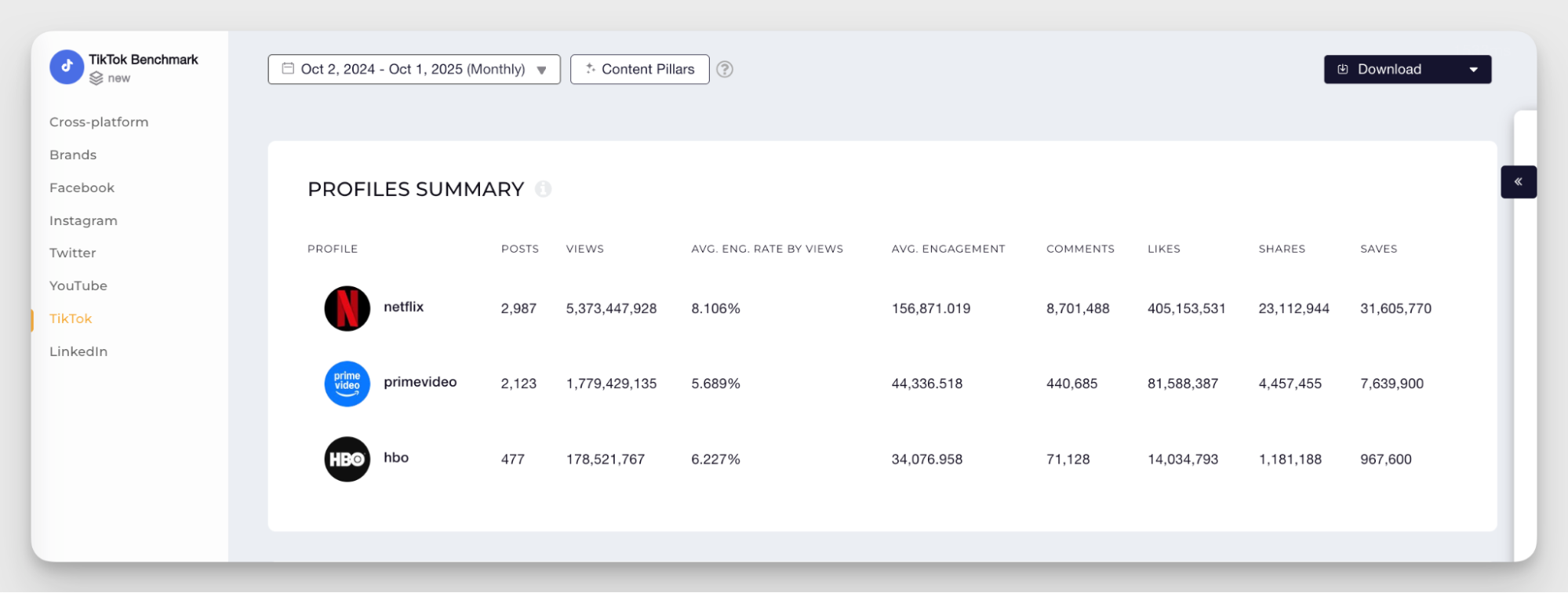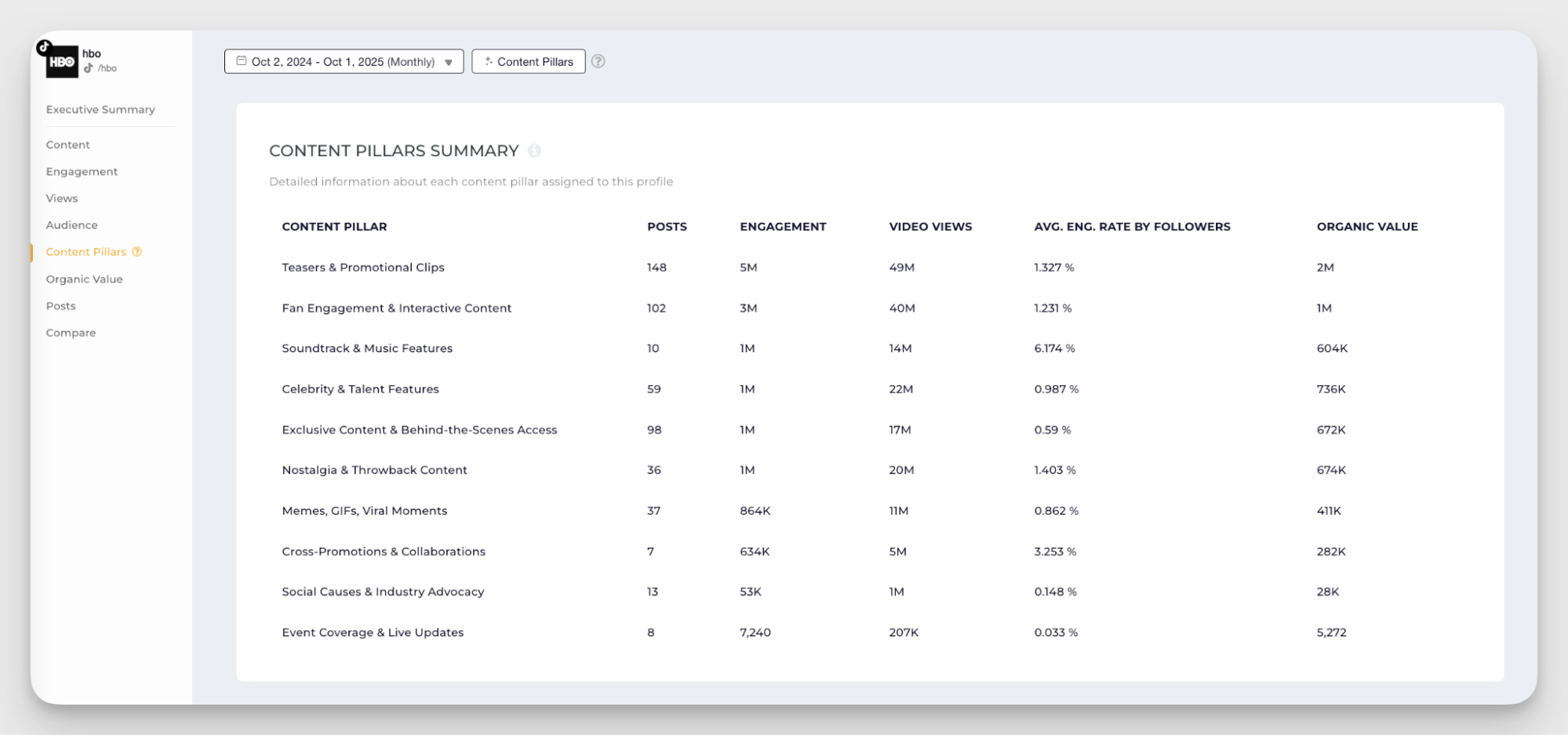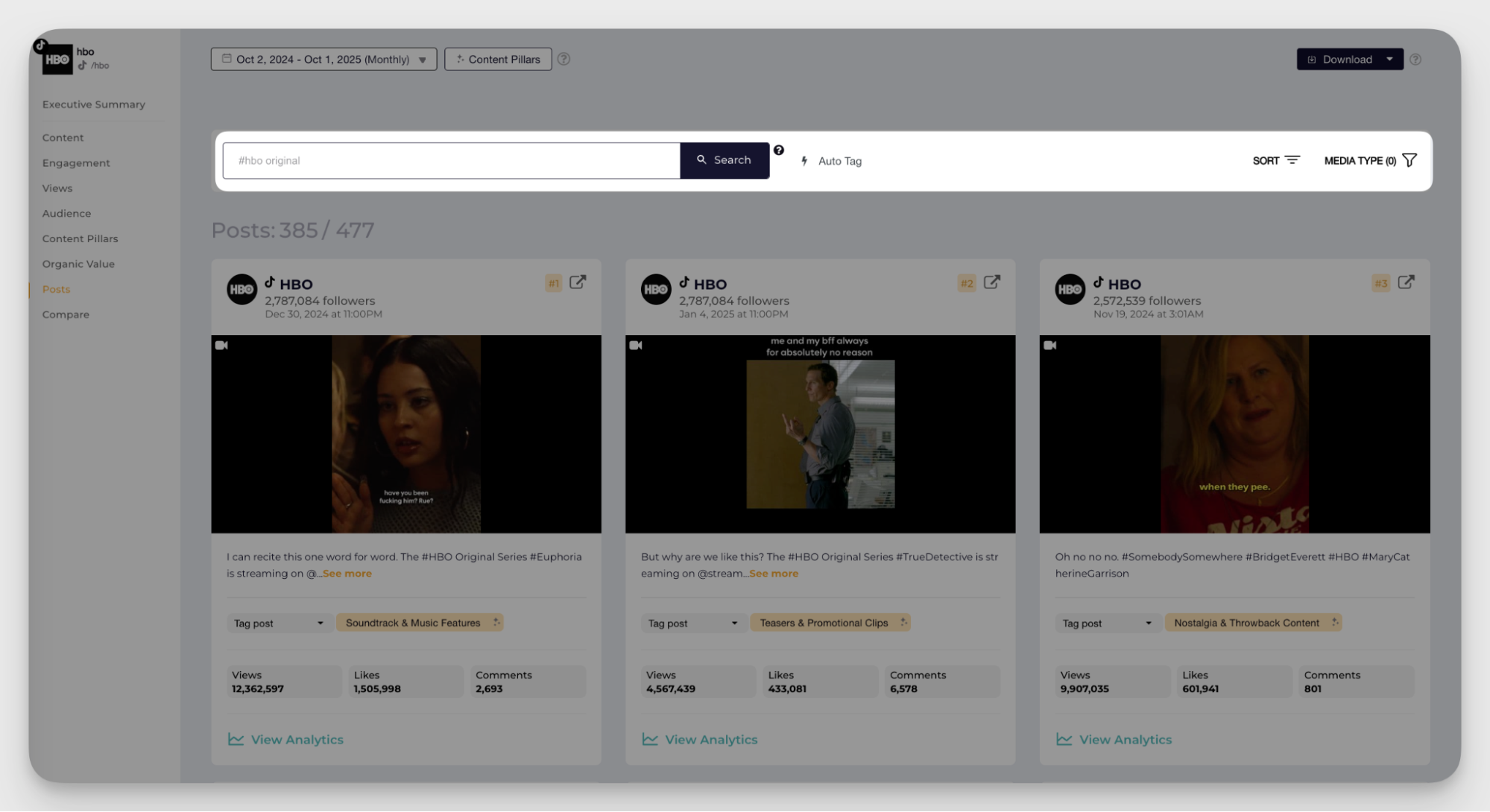Trend Analysis In Social Media: How to Find and Track What's Working
A complete guide to social media trends analysis with actionable strategies and tools. Discover how to find and track what's working today.


Staying ahead of social media trends is how brands maintain relevance and a competitive edge. But as any social media manager knows, that's easier said than done.
Between platform algorithm changes, shifting audience preferences, and competitors moving fast, knowing which trends deserve your attention feels overwhelming.
Time to stop the guesswork. Through this guideI'll show you exactly how to conduct an effective social media analysis for trends, from spotting emerging patterns to measuring their impact on your business goals.
Key takeaways
-
How to spot emerging social media trends? Spot trends early by monitoring platform indicators, competitor performance, and audience conversations to uncover what’s gaining traction before it peaks.
-
How to streamline trends research with Socialinsider? Use Socialinsider to automate competitor tracking, identify high-performing content pillars, and reveal emerging themes across your industry in minutes.
-
What metrics to track to evaluate trend effectiveness? Measure engagement velocity, reach growth, share rate, and conversions to determine which trends truly drive impact for your brand.
-
How to implement trend adoption into your strategy? Evaluate each trend’s relevance, longevity, competitor activity, and brand fit before committing creative resources to ensure authentic, results-driven participation.
-
Trend analysis mistakes to avoid: Avoid chasing every viral topic, ignoring platform context, or missing timing windows — focus on strategic, data-backed trend adoption that fits your brand.
Why is trend analysis critical for competitive positioning?
McKinsey found that companies using data analytics and trend monitoring in marketing see 5–6% higher productivity than those that don’t. Similarly, Google’s 2025 report revealed that marketers focused only on short-term results miss out on half their potential ROI.
Tracking competitors’ social media isn’t just data collection - it’s mapping where your industry is heading and uncovering trends you can use to shape your strategy.
Here’s why it matters:
- Spot opportunities early. The most successful brands aren’t always the biggest — they’re the fastest to act on emerging topics, often doubling engagement by doing so.
- Learn what resonates. Competitors’ top-performing posts offer free insights into your shared audience.
- Allocate resources wisely. Data helps you distinguish short-lived fads from meaningful shifts in content consumption.
- Adapt faster. Platforms evolve quickly; trend tracking helps you stay ahead of algorithm and behavior changes.
With consistent trend monitoring, you can focus on what truly moves your brand metrics, investing in trends that fit your strategy, not just chasing every new format. That’s how you stay ahead, not just keep up.
How to spot emerging social media trends
To paraphrase a famous saying, finding social media trends before they peak is 99% perspiration and 1% inspiration. Though it may seem it’s the other way around, the right tools and tactics help you stay competitive and relevant.
Follow me as I'll walk you through the methods that consistently help brands identify what's gaining traction before their entire industry catches on.
Monitor platform-native trend indicators
Each social platform has built-in signals that show you what's getting people’s attention in real time. These are essential starting points for understanding how to find what's trending.
Start with the obvious places, like Twitter's Trending tab, TikTok's Discover page, Instagram's Explore section, and LinkedIn's news feed. But don't just look at the general trends. Filter by your industry, location, or relevant hashtags to find signals that actually matter for your audience.
When you're checking TikTok trends, pay attention to the audio tracks and effects that are gaining momentum. A trending sound today could be everywhere next week.
What to look for:
- Hashtags with rapidly growing post counts
- Sounds or formats appearing across multiple accounts
- Topics moving from niche communities to broader feeds
- Content types getting platform promotion (like "suggested for you")
Track competitor content performance and engagement spikes
This is where trend analysis of social media gets interesting. Your competitors are creating content every day, and their audience reactions tell you what's working right now.
Let's look at a practical example. When you compare profiles within the same industry, you'll notice patterns in what drives engagement. Take a look at how streaming platforms perform on TikTok. You'll see differences in posting frequency, view counts, and engagement rates that reveal strategic choices.

In this TikTok benchmark analysis performed with Socialinsider, I could see that Netflix posted nearly three thousand times in a month, generating billions of views with a strong engagement rate. Meanwhile, Prime Video posted about two thousand times with slightly lower but still impressive engagement. HBO, with fewer posts, maintained solid engagement metrics that suggest a more selective content approach.
What does this tell you about trending social media topics? When you see one competitor's engagement suddenly spike, that's your signal. They've tapped into something that resonates. Your job is to understand what triggered that response: was it a specific topic, format, or timing?
To track this effectively, set up regular competitive checks. Here's how I suggest you approach this:
- Weekly reviews of top-performing competitor posts;
- Monthly analysis of their content themes and formats;
- Quarterly deep dives into their strategy shifts.
When you notice a competitor's content performing above their baseline, ask yourself (and your team): What changed? Did they adopt a new format? Address a timely topic? Change their posting schedule? These often signal trends worth exploring.
Competitive analysis tools help you spot these patterns without manually checking every competitor's profile daily. You'll see engagement spikes, content performance trends, and format shifts all in one view, making it easier to identify what's working across your competitive set.
Monitor audience conversations and sentiment shifts
Your audience is already telling you what they care about. Are you (really) listening?
Comments, replies, and direct messages contain early signals about changing interests. When you start seeing the same questions or topics come up repeatedly, that's a trend forming in real time.
Pay attention to:
- Questions that appear across multiple posts;
- Topics that generate longer comment threads;
- Sentiment changes around specific subjects;
- Language and phrases your audience starts using.
I've watched brands miss opportunities because they focused only on their own content performance, while their audience was actively discussing other needs and wishes in the competitors’ comments.
My advice is to look at how your audience engages with industry-related content, not just yours. What are they sharing? What sparks debate? Which posts generate saves (a signal that content is valuable enough to revisit)? These social media metrics reveal what matters to your audience right now.
Use social listening for early trend detection
Social listening takes trend tracking beyond your own profiles. It's how you find conversations happening across the entire platform landscape (discussions where your brand might not even be mentioned yet).
Personally, when I approach it, I set listening queries for:
- Industry keywords and terminology;
- Product categories I'm operating in;
- Pain points my solutions addresses;
- Adjacent topics my audience cares about.
You can’t monitor everything, obviously. But you can catch signals early enough to participate in conversations while they're still developing. When you notice a topic gaining momentum in niche communities, you have time to create thoughtful content before it becomes oversaturated.
How to streamline trends research with Socialinsider?
If you tried it, you know: manual trend tracking across multiple competitors is exhausting. I've done it myself and talked to social media managers who spend hours each week or month just trying to keep tabs on what their competitors are posting, let alone analyzing which trends are actually working.
This is where Socialinsider comes in as one of the top tools for social media competitor analysis. Instead of jumping between platforms and spreadsheets, you get a centralized view of trend data that would otherwise take days to compile manually.
For trend analysis, it automates the parts that consume most of your time, such as data collection, content categorization, and performance tracking, so you can focus on the strategic work of identifying which trends matter for your brand.
Leverage industry-specific AI-based content pillars
One of the smartest features for finding trends in data is the AI-powered content pillar analysis. Rather than manually categorizing hundreds of posts to understand what's trending, the tool does this work for you.
Here's how to use it effectively:
Set your analysis timeframe (typically 3 months)
Three months gives you enough data to spot genuine trends without getting lost in daily fluctuations. It's long enough to see patterns emerge but recent enough to be actionable.
When you're analyzing content pillars for social media, this timeframe helps you distinguish between one-off viral moments and sustained content themes that deserve your attention.
Review automated content categorization
The tool automatically sorts content into thematic categories based on what it detects in each post. This saves you from the tedious work of manually tagging and organizing content, which is especially helpful when you're tracking multiple competitors.
You'll see how content is distributed across different themes, making it easier to identify which topics dominate your competitive landscape and which areas might be underserved.
Identify which content types drive the most engagement
Data becomes actionable. When you look at a content pillar summary, you'll see exactly which themes generate the strongest audience response.
Take HBO's TikTok strategy as an example. Their content pillars reveal clear winners: teasers and promotional clips lead in both post volume and engagement, generating millions of interactions and views. Fan engagement content follows with strong performance metrics, while soundtrack features and celebrity content maintain solid engagement rates despite lower post counts.

What stood out to me the most was that nostalgia and throwback content punched above its weight, with fewer posts but strong engagement rates suggesting this content type resonates particularly well with the audience. Meanwhile, memes and viral moments deliver impressive organic reach despite minimal posting.
This breakdown shows what's actually working. When you see a content pillar with high engagement relative to post volume, that's a signal worth investigating further.
Spot patterns and emerging themes
As you review these content pillars over time, you start seeing patterns. Perhaps engagement rates on specific content types are climbing, for example. These are signs of where your industry is heading.
If you ask me, the key to trend-spotting is looking beyond the current top performers. Pay attention to content categories that show increasing engagement, even if they're not dominating yet. These themes might explode in the next quarter.
Conduct a fast competitive analysis
Speed matters when you're trying to stay ahead of trends. The faster you can analyze what's working for competitors, the quicker you can adapt your strategy.
Add your competitors to Socialinsider
Getting started with competitive insights is simple. As Riley Genua from Think Jam discovered, the setup process removes traditional barriers to competitive analysis.
"I realized you could just add a brand immediately, and the data would populate. Like, you didn't have to wait for that data to populate. And that's when I realized, I need to start using this a lot more."
This immediate data access changes how quickly you can respond to trends. When you spot a competitor doing something interesting, you can pull their data right away and understand the full context.
Look at their top-performing posts, analyze key performance indicators
Once your competitors are added, you can see their best-performing content side-by-side. This gives you a clear picture of what's resonating in your industry right now.
When you examine trending social media posts from competitors, you're not just looking at vanity metrics. You're analyzing engagement patterns, audience sentiment, and content formats that drive real results.
- Manually tag posts for specific campaign analysis.
Sometimes you need to go deeper than automated categorization allows. Maybe you're tracking how competitors handle product launches, seasonal campaigns, or crisis response. Manual tagging lets you create custom views for these specific scenarios.
Moving forward with the HBO example I've mentioned earlier, here's how I ran a post-level analysis by tagging content by campaign type. This made it easy for me to track how specific initiatives performed. Below you'll see individual posts tagged with their content pillar (soundtrack features, teasers, nostalgia content) along with detailed performance metrics including views, likes, and comments.

Riley from Think Jam highlights why this capability matters for serious competitive analysis:
"I've been working with at least 10 different social analytics tools... and Socialinsider is really the only tool that does this level of automated content analysis."
This combination of automated insights and manual customization means you can track both broad trends and specific tactical approaches that competitors are testing.
- Select your industry and check the top-performing content pillars of your competitors.
Another thing that I really love about Socialinsider is that you can also compare content pillar performance across multiple competitors in your industry. This reveals what's working across your entire competitive set.
As Riley has noticed in practice: "Using those content pillars, I was able to pretty quickly figure out what people are gravitating towards in the last three months."
The tool makes it easy to get instant visibility into which themes dominate your industry and, more importantly, which ones drive engagement.
For example, when you look at top content pillars across entertainment brands, you'll see clear patterns. Netflix, Prime Video, and HBO all prioritize teasers and promotional content, but their secondary strategies differ. Netflix leans into fan engagement, Prime Video balances promotional content with celebrity features, while HBO emphasizes exclusive behind-the-scenes access.

When multiple competitors succeed with similar content pillars, it confirms a trend. When you spot gaps, such as content types that perform well for one competitor but are ignored by others, that can be your opportunity to step in.
"I think the tool is really smart. And I love the way that everything is displayed, even the micro details, like the post thumbnails. I'm probably in the tool at least every other day," is Riley's overall experience with Socialinsider.
If you want to be competitive, try Socialinsider for free for 14 days. See how easy it is to include social media trends analysis in your daily routine.
What metrics to track to evaluate trend effectiveness?
Finding trends is one thing. Knowing whether they're actually working for your brand is where most teams struggle. I've seen brands jump on trending topics only to realize weeks later they have no idea if it made any difference.
Here's what actually tells you if a trend is worth your continued investment.
Engagement rate and velocity
When you participate in a trend, you should see faster-than-usual engagement in the first few hours. If a post is getting the same slow trickle of likes as your regular content, the trend isn't resonating.
Track these social media engagement signals:
- Engagement rate in the first hour vs. your typical first-hour performance
- Comment-to-like ratio (higher comments often signal trend relevance)
- Save rate for educational or valuable trending content
Velocity matters because trends have short windows. Content that gains momentum quickly benefits from algorithmic promotion while the trend is still hot. Lagging engagement means you've probably missed the peak.
Reach and impressions growth
A successful trend post might deliver two to three times your average reach. Pay attention to:
- Follower growth during trend participation
- Non-follower reach percentage
- Profile visits from trend content
These brand metrics tell you whether the trend helped you access new audiences or just activated your existing community differently.
Share rate and virality indicators
Shares are the ultimate signal that content resonates. Watch for:
- Share rate vs. your baseline
- Where shares are happening (Stories, DMs, external shares)
High share rates often correlate with nailing trends. Cherry on top: If people are still sharing your trend post days/weeks after you published it, you've created something that transcends the immediate trend cycle.
Conversion and business impact metrics
Engagement is great, but does trend participation actually support your business goals?
Connect your trend content to outcomes that matter for your strategy:
- Click-through rate to your website or landing pages
- Conversion rate from trend traffic
- Attribution to sales or sign-ups
- Cost-per-acquisition compared to other content types
I've seen brands celebrate viral trend posts that generated almost no business value. Meanwhile, quieter trend participation with content that aligned closely with their product or service can drive meaningful conversions even with a smaller reach.
How to implement trend adoption into your strategy?
Seeing a trend and jumping on it immediately feels productive. But it’s not necessarily so. Trust me, successful trend adoption follows a systematic evaluation process.
Step #1. Validate trend relevance to your audience
Here's one of my most valuable tips for you. Before you invest any creative resources, ask yourself: Does my audience actually care about this? Look at signals that indicate relevance:
- Are your followers already engaging with this trend?
- Does the trend align with your audience's interests and pain points?
- Have similar brands in your space participated successfully?
- Does the trend topic connect to your content pillars for social media?
Step #2. Analyze trend longevity and momentum
Not all trends are created equal. Some peak fast, generate massive engagement, but fade just as quickly (think Ice Bucket Challenge). Others build slowly and sustain for months or years (think short-form video dominance). Your participation strategy should match the trend's lifecycle.
Use social media analytics tools to assess where they are in their curve:
- Early stage: Low volume but rapidly accelerating, high risk, high reward.
- Peak stage: Maximum visibility but also maximum competition.
- Plateau stage: Sustained interest with less competition, often the sweet spot.
- Decline stage: Fading relevance, probably too late unless you have a unique angle.
Step #3. Benchmark competitor participation and performance
Your competitors are running live experiments with the same trends you're considering. Learn from their results before you commit resources.
When tracking social media posts of competitors around a trend, look for:
- How many competitors have participated?
- What's their engagement compared to their baseline?
- Which creative approaches performed best?
- What mistakes should you avoid?
This competitive benchmarking reveals whether there's still room for your voice in the conversation. If ten competitors have already covered the trend with similar approaches, you'll need a differentiated angle. If only one or two have participated, there's an opportunity.
Step #4. Assess brand fit and creative adaptation potential
This step separates forced trend participation from authentic brand moments. Can you adapt this trend in a way that feels natural for your brand voice and visual identity?
When you're planning how to create content for social media around trends, ask:
- Can we add unique value to this conversation?
- Does participation align with our brand values and voice?
- Do we have the creative resources to execute this well?
- Will our audience see this as authentic or opportunistic?
Brands can damage their credibility by jumping on trends that clearly don't fit their identity. Conversely, brands that consistently find their unique angle on trends build a reputation for being both current and authentic.
Step #5. Calculate potential reach and engagement impact
Finally, estimate whether the effort is worth the potential return. Consider:
- Expected reach based on similar trend content performance
- Estimated engagement using your baseline rates and trend multipliers
- Resource requirements (time, budget, talent)
- Opportunity cost of other content you could create instead
For social media optimization, sometimes the highest-reach trends aren't the best investment. A smaller, more targeted trend that deeply resonates with your core audience might deliver better business results than a massive trend with superficial engagement.
Trend analysis mistakes to avoid
I’ve already touched on a few of these in passing, but let’s clearly outline common mistakes with trend analysis so you can avoid them.
Chasing every trend without a strategy
Trend participation is not a volume game. Brands that jump on every trending topic just look desperate for attention.
When you abandon your core content strategy to chase every viral moment, you confuse your audience.
The fix requires discipline: establish clear criteria for trend participation tied to your social media content strategy. Maybe you only participate in trends that align with specific content pillars. Or you limit trend content to 20% of your posting schedule.
Ignoring platform-specific context
A trend that works on TikTok doesn't automatically work on LinkedIn or even Instagram. Yet brands constantly make this mistake, copying trend approaches across platforms without adapting to context. That’s lazy.
Consider how social media best practices vary by platform. My advice? Don't force a format just because it's trending elsewhere. Adapt the core idea to fit the platform's native content style or simply stick with one platform and do it well.
Missing the optimal timing window
Timing is everything with trends. Too early, and no one recognizes what you're referencing. Too late, and you look out of touch.
Here are a few rules from experience:
- Breaking news trends - Participate within hours or skip entirely.
- Platform features - Jump in during the first weeks for algorithmic favor.
- Seasonal trends - Start one week before peak interest.
- Industry movements - Contribute throughout the lifecycle with fresh angles.
Examples of brands that nail trend participation
The reason I chose entertainment brands as examples throughout this article is that they pretty much nail social media trend participation.
My analysis shows that brands like Netflix, Prime Video, and HBO are keen observers of trends. They participate when it makes sense, analyze what works for their audience, and test new approaches smartly.
- Netflix posts with high volume and variety, testing multiple trend formats to see what resonates. They embrace experimentation and are not afraid to try dance trends, meme formats, behind-the-scenes content, and interactive challenges. This strategy helps them catch trend waves early and often.

- Prime Video takes a more selective approach, focusing on fan engagement and interactive content that encourages participation. They excel at adapting trends to showcase their talent and properties in ways that feel native to TikTok's culture.

- HBO demonstrates that you don't need the highest posting frequency to succeed with trends. Their strategy emphasizes quality and strong engagement rates through carefully selected trend participation. They lean into nostalgia and exclusive content, formats that align naturally with their premium brand positioning.

What you can learn from their approach:
- Find your trend voice and stick to it. Each of these brands has a distinct personality in how they approach trends. Netflix is playful and experimental. Prime Video is interactive and fan-focused. HBO is selective and premium.
- Balance promotional and pure entertainment content. Yes, they're using trends to market shows and movies. But they don't make every trend post a hard sell. Much of their top-performing content entertains first, promotes second.
- Adapt trends to showcase your unique assets. These brands adapt trends to highlight their unique assets rather than forcing themselves into formats that don't play to their strengths.
- Use data to refine your approach. They're clearly tracking trends and adjusting based on results. You can see evolution in their strategies based on performance patterns.
Final thoughts
Trend analysis is the opposite of chasing every viral moment. It's about building a systematic approach to identifying and evaluating opportunities that align with your brand strategy.
Start with the framework we've covered: spot trends early through platform signals and competitor monitoring, evaluate them against clear criteria, and measure results to inform future decisions.
If you want to streamline your trend research and competitive analysis, try Socialinsider free for 14 days and see how automated insights can transform hours of manual work into minutes of strategic decision-making.
Analyze your competitors in seconds
Track & analyze your competitors and get top social media metrics and more!
You might also like
Improve your social media strategy with Socialinsider!
Use in-depth data to measure your social accounts’ performance, analyze competitors, and gain insights to improve your strategy.




